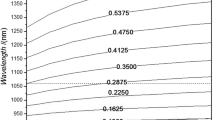Abstract
Compressive-strained InAlGaAs quantum wells (QWs) were grown on GaAs substrates by metal organic chemical vapor deposition (MOCVD). The influences of reactor pressure, V/III ratio, growth temperature, and substrate orientation on the quality of InAlGaAs QWs were studied using high resolution X-ray diffraction (HR-XRD), photoluminescence (PL) and atomic force microscope (AFM) measurements. The PL results indicate that the PL intensity and full width at the half-maximum (FWHM) of QWs are very sensitive to the growth conditions such as reactor pressure, growth temperature, and substrate orientation. The AFM results demonstrate that the growth mode of epilayer is dominated by the orientation of substrate. The growth mode of samples grown on 0.5° miscut and 2° miscut substrates is step flow and step bunching, respectively. The samples grown on 0.5° miscut substrates have higher PL intensity comparison with the samples grown on 2° miscut substrates at the same growth conditions. The PL and AFM results of sample grown at 700 °C and a pressure of 50 mbar with a V/III ratio of 100 indicated that these growth parameters are close to the optimum growth conditions for InAlGaAs QWs.







Similar content being viewed by others
References
J. Zhang, Y.Q. Ning, Y.G. Zeng, J.W. Zhang, J.L. Zhang, X.H. Fu, C.Z. Tong, L.J. Wang, Design and analysis of high-temperature operating 795 nm VCSELs for chip-scale atomic clocks. Laser Phys. Lett. 113, 45802–45806 (2013)
A.E. Zhukov, L.V. Asryan, E.S. Semenova, F.I. Zubov, N.V. Kryzhanovskaya, M.V. Maximov, On the optimization of asymmetric barrier layers in InAlGaAs/AlGaAs laser heterostructures on GaAs substrates. Semiconductors 49, 935–938 (2015)
J.W. Shi, W.C. Weng, F.M. Kuo, Y.J. Yang, S. Pinches, M. Geen, A. Joel, High-performance Zn-diffusion 850-nm vertical-cavity surface-emitting lasers with strained InAlGaAs multiple quantum wells. IEEE Photonics J. 2, 960–966 (2010)
J. Genest, J.J. Dubowski, V. Aimez, Suppressed intermixing in InAlGaAs/AlGaAs/GaAs and AlGaAs/GaAs quantum well heterostructures irradiated with a KrF excimer laser. Appl. Phys. A Mater. 89, 423–426 (2007)
Y. Qu, S. Yuan, C.Y. Liu, B.X. Bo, G.J. Liu, H.L. Jiang, High-power InAlGaAs/GaAs and AlGaAs/GaAs semiconductor laser arrays emitting at 808 nm. IEEE Photonic Tech. L. 16, 389–391 (2004)
J.R. Jensen, J.M. Hvam, W. Langbein, Optical properties of InAlGaAs quantum wells: Influence of segregation and band bowing. J. Appl. Phys. 86, 2584–2589 (1999)
K. Makita, I. Watanabe, M. Tsuji, K. Taguchi, Dark current and breakdown analysis in In(Al)GaAs/InAlAs superlattice avalanche photodiodes. Jpn. J. Appl. Phys. 35, 3440–3444 (1996)
G.P. Kothiyal, S. Hong, N. Debbar, P.K. Bhattacharya, J. Singh, Enhancement in excitonic absorption due to overlap in heavy-hole and light-hole excitons in GaAs/InAlGaAs quantum-well structures. Appl. Phys. Lett. 51, 1091–1093 (1987)
T.W. Schlereth, C. Schneider, S. Hofling, A. Forchel, Tailoring of morphology and emission wavelength of AlGaInAs quantum dots. Nanotechnology 19, 045601 (2008)
S. Chika, H. Kato, M. Nakayama, Temperature dependence of molecular beam epitaxial growth rates for InxGa1–xAs and InxAl1–xAs. Jpn. J. Appl. Phys. 25, 1441–1442 (1986)
W.T. Tsang, The influence of bulk nonradiative recombination in the wide band-gap regions of molecular beam epitaxially grown GaAs-AIGaAs DH lasers. Appl. Phys. Lett. 33, 245–248 (1978)
W.T. Tsang, F.K. Reinhart, J.A. Ditzenberger, The effect of substrate temperature on the current threshold of GaAs-AlGaAs double heterostructure lasers grown by molecular beam epitaxy. Appl. Phys. Lett. 36, 118–121 (1980)
J. Singh, K.K. Bajaj, Role of interface roughness and alloy disorder in photoluminescence in quantum-well structures. J. Appl. Phys. 57, 5433–5437 (1985)
A. Jasik, A. Wnuk, A. Wojcik-Jedlinska, R. Jakiela, J. Muszalski, W. Strupinski, M. Bugajski, The influence of the growth temperature and interruption time on the crystal quality of InGaAs/GaAs QW structures grown by MBE and MOCVD methods. J. Cryst. Growth 310, 2785–2792 (2008)
A. Jasik, A. Wnuk, J. Gaca et al., The influence of the growth rate and V/III ratio on the crystal quality of InGaAs/GaAs QW structures grown by MBE and MOCVD methods. J. Cryst. Growth 311, 4423–4432 (2009)
N. Inoue, K. Ikuta, M. Shinohara, J. Osaka, Interface structures in GaAsAl(Ga)As quantum wells controlled by metalorganic vapor phase epitaxy and molecular beam epitaxy. J. Cryst. Growth 146, 379–383 (1995)
M. Shinohara, N. Inoue, Behavior and mechanism of step bunching during metal organic vapor phase epitaxy of GaAs. Appl. Phys. Lett. 66, 1936–1938 (1995)
J.H. Neave, P.J. Dobson, B.A. Joyce, J. Zhang, Reflection high-energy electron diffraction oscillations from vicinal surfaces-a new approach to surface diffusion measurements. Appl. Phys. Lett. 47, 100–102 (1985)
T. Nishinaga, K. Cho, Theoretical study of mode transition between 2d-nucleation and step flow in MBE growth of GaAs. Jpn. J. Appl. Phys. 27, L12–L12 (1988)
F. Bugge, U. Zeimer, M. Sato, M. Weyers, G. Trankle, MOVPE growth of highly strained InGaAs/GaAs quantum wells. J. Cryst. Growth 183, 511–518 (1997)
K. Muraki, S. Fukatsu, Y. Shiraki, R. Ito, Surface segregation of In atoms during molecular beam epitaxy and its influence on the energy levels in InGaAs/GaAs quantum wells. Appl. Phys. Lett. 61, 557–559 (1992)
P.D. Dapkus, H.M. Manasevit, K.L. Hess et al., High purity GaAs prepared from trimethylgallium and arsine. J. Cryst. Growth 55, 10–23 (1981)
Acknowledgements
This work was supported by the National Natural Science Foundation of China under contract No. 61604171 and 61804086, and the Jiangsu Province Science Foundation for Youths under contract No. BK20170431.
Author information
Authors and Affiliations
Corresponding authors
Rights and permissions
About this article
Cite this article
Zhao, Y., Huang, J., Sun, Y. et al. Influence of growth conditions on the quality of strained InAlGaAs/AlGaAs quantum wells grown by MOCVD. Appl. Phys. A 125, 117 (2019). https://doi.org/10.1007/s00339-019-2411-5
Received:
Accepted:
Published:
DOI: https://doi.org/10.1007/s00339-019-2411-5




